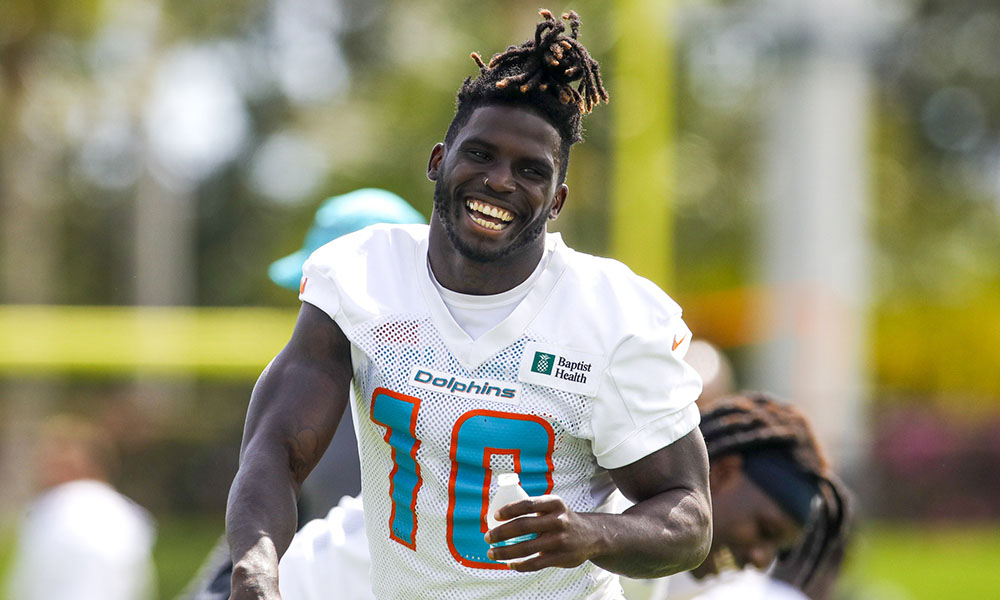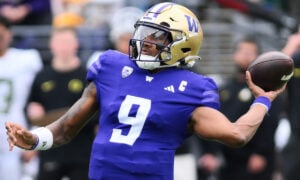Optimisery: The Case for and Against Tyreek Hill in Miami

In this series, Jeremy Schwob and John Di Bari present the optimistic and pessimistic sides to significant changes in the dynasty landscape. Consider both sides, as the goal is to find somewhere in between.
The old adage that there are two sides to every coin could never be more true than when circumstances change for a player. That is especially true when surprising information is thrust upon us. Psychological difficulty and distress can be encountered when individuals hold rigid views that are strictly one-sided (i.e., split) or alternate drastically from one to the other.
A therapeutic concept called integration is a healthier structure for holding both sides together and tolerating the benefits and flaws simultaneously. Relationally, this could involve being frustrated or angry with them while at the same time being able to maintain that you care about them. Such emotional difficulties can parallel our view of players on dynasty rosters amidst changing circumstances.
The goal of this series is not to have you pick a side or a winner of the argument. Rather, it is to consider both sides and not select one completely in the absence of the other.
In an off-season where we saw numerous big names on the move, one of the biggest players in the fantasy community to find a new home in 2022 was the Chiefs’ Tyreek Hill. Hill was traded from Kansas City to Miami for a package of picks, and the ‘Phins quickly signed him to a massive four-year, $120 million deal.
Was Hill a product of the Andy Reid/Patrick Mahomes offense in Kansas City? Or was he the straw that stirred the drink, and the Chiefs’ explosive offense was the product of his presence? Either way – and more importantly for our purposes here – will Hill’s arrival in South Beach produce more of the same we’ve been accustomed to over the last few years, or will we see a significant drop in his production?
OPTIMISM
How can it even be possible to fathom that losing Patrick Mahomes as your quarterback can be positive? Well, it’s not. But what if it remains a reasonably lateral move? This, of course, begins as a conversation about your opinion of third-year quarterback Tua Tagovailoa.
One of the main concerns about the quarterback transition from Mahomes to Tagovailoa is related explicitly to deep passes, where Hill’s speed can be maximized. Tagovailoa has been viewed as a quarterback prioritizing accuracy over risk, despite some questionable throws and turnovers in his young career. His 6.6. career yards per attempt would be suggestive of that approach. That leads many in the dynasty community to be fearful of the transition.
However, as Mike Florio notes, Tagovailoa is in impressive company regarding his 15.8 yards per attempt on deep passes – those traveling 20+ air yards. The smaller sample size here is important to note, but this may be a case of much ado about nothing or even much ado about strength.
The only QBs ahead of Tua (15.8) in yards per attempt on passes of 20+ air yards
– Matthew Stafford, 20.3
– Matt Ryan, 17.1
– Joe Burrow, 16.1He has a small sample throwing the deep ball in the NFL, but in the bit he has, it’s been better than the narratives let on
— Michael F. Florio (@MichaelFFlorio) July 5, 2022
Another potential concern is target volume. Hill is coming off a career-high 111 receptions on 159 targets, which he translated to another 12,00-yard season. Along with him in the passing game is second-year star Jaylen Waddle. Waddle comes off an incredibly impressive 104-1,015-6 line on 140 targets in 2021.
Hill has been accustomed to such target competition throughout his career, as former Chiefs teammate Travis Kelce demanded huge target volume year over year – averaging 134 targets during their time as teammates. Of note, the Dolphins’ passing game also entails contract-year tight end Mike Gesicki. He is also coming off a career year in targets (112), receptions (73), and yards (780) and will continue to be a contributor. Though, the Dolphins trading for Hill and immediately signing him to a four-year, $120m extension ($72.2m guaranteed) suggests he will remain the offensive focal point despite changing teams.
The most pressing concern may be the touchdown volume decrease from Mahomes (38, 37) and Tagovailoa (11, 16) in 2020 and 2021, respectively. That sizable gap is difficult to explain away. However, you can certainly suggest that Hill contributed to those numbers in some capacity. His 56 touchdowns since entering the league in 2016 rank third behind only Davante Adams and Mike Evans. Again, fairly productive quarterbacks were throwing those guys the ball (including Jameis Winston), but the receivers played significant roles in achieving such success.
– Schwob
PESSIMISM
Where to begin? Since Patrick Mahomes took over the starting quarterback job in Kansas City, the Chiefs have thrown a pass on approximately 62% of plays. Last season, that was the sixth-highest percentage in the NFL. Head coach Andy Reid has been very pass-happy and featured Tyreek Hill in a prominent role in that offense.
Conversely, looking at the Dolphins’ current brain trust, we might not see Hill in an offense nearly as friendly as we’ve been accustomed to in the past. In new head coach Mike McDaniels’s single season as an offensive coordinator, his team passed 51% of the time – 29th out of 32 teams. In previous seasons as an offensive assistant and passing game coordinator, his teams passed 56% of the time. The Dolphins’ new quarterback coach and passing game coordinator – Darrell Bevell – has a longer and more damning track record. In Bevell’s 15-year career as an offensive coordinator in the NFL, his teams have passed only 54% of the time.
Over the last two seasons, with Tagovailoa at the helm, the Dolphins’ top three receivers accounted for 48% of the team’s targets, while their top two receivers accounted for 37%. By comparison, the Chiefs’ top three receivers have accounted for 54% of the team’s targets with Mahomes under center, while their top two receivers were responsible for 42%. On average, the Tagovailoa-led Dolphins have passed 583 times per season, and the Mahomes-led Chiefs have passed 592 times per season.
The Chiefs, for years, have had a very narrow distribution tree, and Hill was one of the top beneficiaries of that. He is going from a high-volume passing attack, where he was always one of the top two targets, to a new team with what should be a lower volume passing attack where he is now one of three players that should be heavily involved each week. Hill went from getting half of a bigger pie to a third of a smaller pie. Volume is essential in fantasy, and although he could see an uptick in efficiency despite seeing less volume, the loss in volume will definitely hurt Hill’s numbers going forward in Miami.
Over Hill’s last three full seasons in KC, he averaged 95 receptions, 1,331 yards, and 12 touchdowns. However, looking at the numbers for player over/under totals, you can see the oddsmakers are anticipating a dip in Hill’s production. The oddsmakers predict that Hill will put up an 82.5-catch, 995.5-yard, 7.5-touchdown season. Over the course of an entire season, those numbers would total 227 PPR fantasy points. A year ago, 227 points would have led to a WR21 finish – a far cry from the WR1, top-five finishes we’ve become accustomed to from Hill.
– Di Bari
Ultimately, you must make decisions in dynasty but confront that which does not fit your desired perspective. As uncomfortable as it is, it’s essential to work diligently to integrate the alternative into your overall concept to make more informed decisions.
Regardless of your excitement or concern, Hill has proven to be an elite player on the field. He changes the way the defense must play and elevates the play and opportunity for those around him. In a numbers game, though, his ceiling and floor have become a bit more unsettled after losing the league’s best young quarterback.
- Optimisery: The Case For and Against David Montgomery in Detroit - August 14, 2023
- Optimisery: The Case For and Against Miles Sanders in Carolina - August 9, 2023
- Optimisery: The Case For and Against DJ Moore in Chicago - August 2, 2023


































































